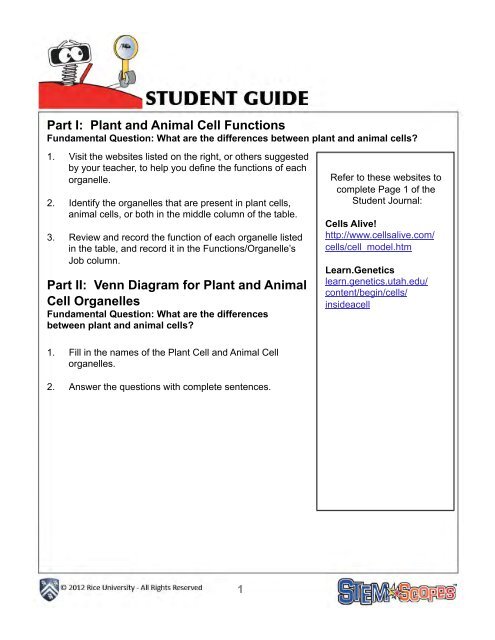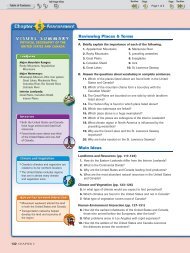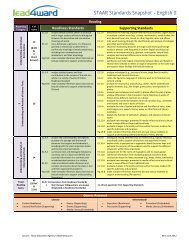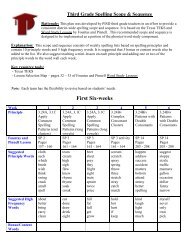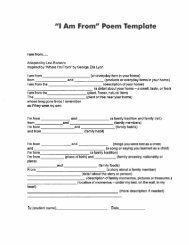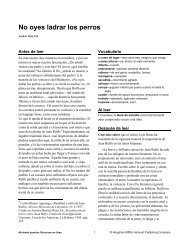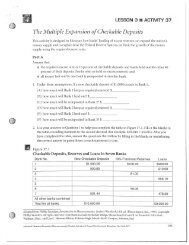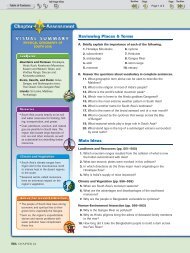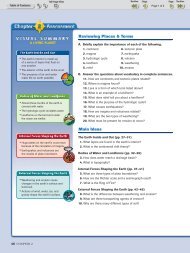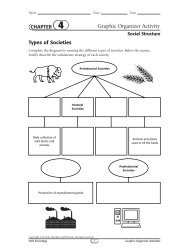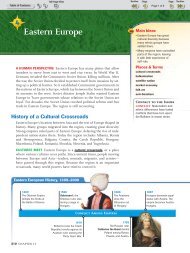Plant and Animal Cells Student Guide
Plant and Animal Cells Student Guide
Plant and Animal Cells Student Guide
Create successful ePaper yourself
Turn your PDF publications into a flip-book with our unique Google optimized e-Paper software.
Part I: <strong>Plant</strong> <strong>and</strong> <strong>Animal</strong> Cell Functions<br />
Fundamental Question: What are the differences between plant <strong>and</strong> animal cells?<br />
1. Visit the websites listed on the right, or others suggested<br />
by your teacher, to help you define the functions of each<br />
organelle.<br />
2. Identify the organelles that are present in plant cells,<br />
animal cells, or both in the middle column of the table.<br />
3. Review <strong>and</strong> record the function of each organelle listed<br />
in the table, <strong>and</strong> record it in the Functions/Organelle’s<br />
Job column.<br />
Part II: Venn Diagram for <strong>Plant</strong> <strong>and</strong> <strong>Animal</strong><br />
Cell Organelles<br />
Fundamental Question: What are the differences<br />
between plant <strong>and</strong> animal cells?<br />
Refer to these websites to<br />
complete Page 1 of the<br />
<strong>Student</strong> Journal:<br />
<strong>Cells</strong> Alive!<br />
http://www.cellsalive.com/<br />
cells/cell_model.htm<br />
Learn.Genetics<br />
learn.genetics.utah.edu/<br />
content/begin/cells/<br />
insideacell<br />
1. Fill in the names of the <strong>Plant</strong> Cell <strong>and</strong> <strong>Animal</strong> Cell<br />
organelles.<br />
2. Answer the questions with complete sentences.<br />
1
7.5A: Photosynthesis<br />
Matter <strong>and</strong> Energy<br />
Part III: Mad Scientist Cookbook<br />
Fundamental Question: What are the differences between plant <strong>and</strong> animal cells?<br />
1. Even Mad Scientists need cookbooks! You’re a Mad<br />
Scientist that needs to create a recipe for a type of<br />
plant or animal cell to contribute to the Mad Scientist<br />
Cookbook.<br />
2. Choose a type of cell from a plant or animal. Use your<br />
notes from Parts I <strong>and</strong> II, Internet resources, <strong>and</strong><br />
library reference books to fill in the recipe page in your<br />
<strong>Student</strong> Journal. Be specific. For example, choose a<br />
stomach cell, a liver cell, or a phloem cell. Though all<br />
animal cells contain the same organelles, they may<br />
differ in appearance depending on their function.<br />
<strong>Plant</strong>s also have different cells for different plant parts<br />
such as root hairs or leaves.<br />
Examples of <strong>Animal</strong> <strong>Cells</strong><br />
Nerve cells<br />
Red blood cells<br />
Muscle cells<br />
3. Below the ingredient list on your recipe page, fill in the<br />
“cooking” directions. This explains the function of<br />
each organelle in your cell.<br />
4. Fold the top part of your recipe page over to conceal<br />
the name of your cell. Exchange recipes with a<br />
partner (another Mad Scientist). Do not peek at the<br />
name!<br />
5. On a separate, blank sheet of paper, draw the cell<br />
according to the recipe your partner has given you.<br />
Label the organelles <strong>and</strong> write the name of the cell,<br />
determining whether it is an animal or a plant cell.<br />
6. Meet with your partner <strong>and</strong> discuss your drawings.<br />
Did you guess correctly? Were any organelles<br />
forgotten? Update your illustration, if needed.<br />
Moss leaf<br />
cells<br />
Broad bean<br />
root tip cells<br />
Broad bean<br />
leaf cells<br />
2


